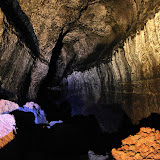
A rock stuck in the lava flow

From the lower end we hiked back to the lower entrance and got out to grab a bite to eat before heading back down to do the upper section of the cave. Soon after we started, we found the first pile of rocks. This portion is probably a section of the cave that at some point collapsed. Reading the description, it would seem that these are small rocks and a short distance. The reality is a bit different as this is a big pile of very big rocks. Right after that, Nancy and I were surprised to see some very little mushrooms growing in total darkness in the cave.
Mushrooms growing in total darkness

From there we continued thru several rock piles, tunnels and turns. Although everything seems to be similar, ever turn looked different from the previous one. The colors on the walls and ceiling constantly changed as did the shapes and surface of the walls. In several places the cave had a protrusion creating something like a mezzanine. In one particular section, these protrusions merged into one forming a curved ceiling that looked like a temple.
The temple

Further up in the cave, we got a bit of light from the outside as the cave has a vent that goes to the surface. Not long after that, we got to the staircase climbs out the upper entrance of the cave. At that point we decided to rest for a while before hiking down, on the surface, back to the parking lot. On that hike, it was interesting to see what the outside of the cave would look like. We found numerous holes and rocks with clear marks of lava flow.
Since this trip was not very long, I decided to complement it with a short walk around the Trail of Two Forests. This is a small section close to the cave that formed in the same eruption as the Ape Cave. As Lava was flowing on the surface and cooling down, it went around trees that burned with the extreme heat. Since the lava was already cooling down, it took longer for the trees to burn than for the lava to solidify. Once the trees burned, the lava didn’t continue to move leaving a cast of the tree that was there. Around this trail you can see numerous holes where there were trees. What’s even more interesting is that there where a couple of down trees that formed a couple of crossing tubes that you can crawl thru. Just imagine being inside a tube where the walls are a clear impression of a tree that was in its place. It was truly fantastic.
No comments:
Post a Comment